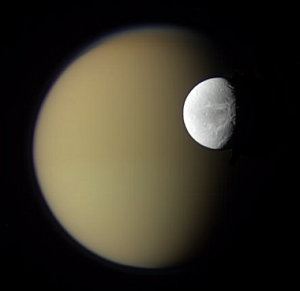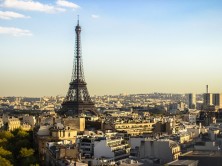
The above image was created and labeled as a composite image by Emily Lakdawalla. NASA was accused of conspiracy to cover-up by some bloggers, even though Lakdawalla isn't affiliated with the agency. (Credit: Astronomy Picture of the Day)
Even though a planetary scientist and blogger for the Planetary Society disclosed and clearly explained her Photoshopped image of Saturn’s moons, she and NASA were labeled as part of a “conspiracy cover-up” in the blogosphere. And, despite reports claiming NASA is behind the conspiracy, the scientist who created the composite image isn’t even affiliated with NASA.
(Full disclosure: iMediaEthics’ publisher, not-for-profit, Art Science Research Laboratory, publishes NASA’s Astrobiology Magazine ).
“I have never had any affiliation with NASA,” Emily Lakdawalla, the scientist who used NASA’s photos to create a Photoshopped image, wrote to iMediaEthics. “The headline I have is, for example, from Fox News’ website; ‘Conspiracy Theorists Confident: Altered Image a NASA Cover-Up.’ Technically that is not incorrect, as I’m sure the conspiracy theorists are confident that the image is some sort of cover-up. But the ‘conspiracy theorists’ are wrong that NASA had anything to do with the Photoshopping of the image.”
Lakdawalla created and posted a composite image of Saturn’s moons on her blog here. Astronomy Picture of the Day’s editor Robert Nemiroff selected her composite – created from images off NASA’s Cassini website – as April 20’s image of the day. “it’s not like NASA employees don’t use Photoshop for image processing; every press-released image has some work done to it, if only to adjust contrast and brightness,” Lakdawalla wrote to StinkyJournalism.
As Geek.com explained, the controversy over her photo started after YouTube user DominatorPS3 criticized the editing.
“A YouTube user called DominatorPS3 noticed that when you turn up the contrast of the image, a lot of brush strokes on the dark side of the smaller moon become visible… immediately leading him to surmise that there was a cover-up afoot to keep the public from knowing the truth about extraterrestrial life around Saturn.”
DominatorPS3’s claims were picked up by Australian news site News.com.au, Fox News, and Gawker-owned blog i09.
Lakdawalla, the scientist who created the composite image (and disclosed and explained the editing), told iMediaEthics via e-mail that she learned about the claims via Phil Plait, a Discover blogger on badastronomy.com. She wrote that she hasn’t had any contact with DominatorPS3, and that that user’s response to her image “is the most extreme reaction I’ve ever experience; nearly all responses and comments I receive are positive.”
“I was actually pleased by the Web articles’ reference to my blog and quoting of my explanation of why this sort of photo manipulation is necessary. The headlines were ridiculous but the text was relatively dismissive of DominatorPS3’s odd claims,” Lakdawalla wrote.
The Photoshopped image of Saturn’s moons Dione and Titan was first published here in an April 12 blogpost on the nonprofit Planetary Society website. The image is labeled as a composite and included links to other posts of Lakdawalla’s explanation of how to make similar composites.
Discovery News’ Mark Thompson explained Oct. 13 the “media frenzy” that followed reports of the Photoshop. Thompson noted that Planetary Society’s Emily Lakdawalla hadn’t really altered the image too much.
“What had she done? Nothing more than the astronomical equivalent to removing red eye, but for some reason it’s okay for us all to touch up pictures of ourselves but not okay for scientists to touch up pictures of the universe,” Thompson wrote.
The photos of Saturn’s moons were taken by the Cassini spacecraft, which takes “raw images” of the moons “by taking individual shots through red, green and blue filters that are then recombined to make the final color picture,” Thompson wrote. Because the photos are taken on “a moving spacecraft, the red, green and blue images can be out of alignment, so Emily had corrected for this.”
Thompson didn’t seem to see what the big deal was over the Photoshop. “After all, nearly every image of the universe released by NASA or indeed anyone (even me) has more than likely had something done to it; be it to sharpen it up a little, remove bits of dust on the lens, bring out more detail or even to correct for a slight misalignment of individual color images.”
Lakdawalla again explained the image and the claims of conspiracy in her own Oct. 8 blogpost. “Some guy on YouTube” – DominatorPS3 – had posted a video about the “cover-up” and then news services reported it. She wrote in that blogpost explaining that the image is “a relatively quick and dirty color composite of three views of Titan and Dione captured by Cassini through red, green, and blue filters.” She then detailed how to find where she painted over some marks in the image – the “conspiracy.”
“If you download this image and open it in a paint program and increase the contrast, you’ll see the brush strokes on the night side of Dione where I painted out some misalignment in the three component images that resulted from Dione’s apparent motion across Titan in the time that separated the three frames. Which is apparently a NASA conspiracy,” Lakdawalla wrote.
News.com.au reported that DominatorPS3 wasn’t satisfied with Lakdawalla’s explanation. “Thanks for the feedback and explanation,” he said in a comment on the YouTube post. “However I still remain sceptical because someone still could have ordered her to ‘cut it or something out’. But thanks for putting that info up so others can read it; I am not trying to convince people what I believe.”
Either way, Lakdawalla wrote to iMediaEthics that as a result of the media attention from the image, she intends to “revisit this particular set of images once the Cassini imaging team releases the better-quality, archived science data to the public, which will happen on or about April 1, 2011. (It’s ironic and coincidental that the data release will happen on April Fool’s Day!)”
Also, she told iMediaEthics she intends to “be more careful” providing links to the original images. That way, readers can compare her composites or edits with the originals.






